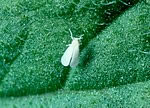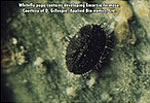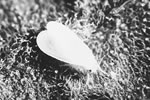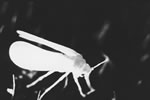Some Background

Like aphids, whiteflies are members of the Homopteran order. And like their cousins, are widely distributed pests. With several species being problematic in greenhouse crops. Whiteflies attack a huge assortment of vegetable, herb and floral crops, causing, perhaps, millions in damage every year across the United States. Fortunately, they are one of the easiest pests to detect and identify-at least in the cursory sense. Further identification is rather important if you’re planning to prevent whiteflies (highly recommended) or deal with them while still in small numbers.
How They Become a Problem

As things begin to warm up in the spring — or much earlier in greenhouses — whiteflies can show up. Normally, to observant growers, a flitting white insect or two may be seen in or around the crop. If this is your situation, you should act immediately, especially if you haven’t already initiated your control program. If your initiative is biological-based, you’ll need to know the identification of your whitefly, at least at the genus level. There are a small handful of whiteflies which infest greenhouse crops, of which are three species from two genera which are usually the troublemakers (more on this in a bit). If you’re just starting out and this is your first time dealing with whiteflies, or if you don’t have historical records or experience to rely upon, you’ll either need to get some help or to spend a little more money so that all your bases are covered. Since the three species can be a problem just about anywhere in the country, one of the best ways you can at least get an edge on which species are most prevalent in your locality is through your university’s cooperative extension. They should be able to clue you in-at least to give your odds better than 50/50. Once you’ve determined your area’s typical whitefly species, this is the species you’ll usually have in the future-unless you start bringing in plant material from new sources.
Often whiteflies come in on purchased plant material. When that’s not the case, though, they usually come in from outdoors or from their winter hiding places. The female whitefly, upon entering the facility, will typically lay her eggs on a desirable plant located very close to the opening in which she came. This might be, as an example, in close proximity to fans, vents, etc. She’ll lay a circular pattern of eggs on the underside of newer leaves located in the upper portions of the plants. The eggs are white, but darken as they get closer to hatching. When the eggs hatch, the subsequent larvae move a short distance then set up shop, feeding and growing in size as they edge closer to maturity. Like thrips, whiteflies undergo a somewhat mixed metamorphosis-somewhere between complete and incomplete. Their larval and pupal stages are very similar in appearance — they all look like little scales. From the pupae, new whitefly adults emerge to mate and repeat the cycle spreading the problem throughout the crop. As this process continues, the stages or instars seem to be found lower on the plants. The whitefly immatures do not move, but the plants continue to put forth new growth thus putting these pests on a sort of time-line. Top of plants: eggs and adults. Middle sections: larvae. Bottom sections of plants: pupae and new adults (which fly outward and upward seeking a mate and new place to lay eggs). This information can help you in determining the age of the infestation, the seriousness of the problem, and where to look for the pupae for identification purposes.
A Serious Pest

The whitefly pupal stage is the easiest stage in which one can most accurately identify whiteflies. Identification is very important. Here’s why: One of the parasitoids available for control, Encarsia formosa, prefers greenhouse whitefly, Trialeurodes vaporariorum, and it may take several generations before acclimating to a different genus. Another popular parasitoid, Eretmocerus eremicus, prefers the B-whitefly species; ‘B’ for the Bemisia spp. Bemisia argentifolii, or the silverleaf whitefly is one, and B. tabaci, or the sweet potato whitefly is the other. Like E. formosa, E. eremicus may take several generations before acclimating to a different genus. This is why knowing which genus of whitefly you have is so important. Choosing wrong can cost you valuable time. And all are found in greenhouses so there are no clues there. If your plan is to prevent whiteflies before they show up, you’ll need to know which type you’ll likely encounter. Otherwise you’ll end up releasing both parasitoids as insurance, and that can be cost prohibitive.
Greenhouse whitefly pupae are off-white and coin-like. There is a distinct vertical surface, as viewed from the side, along the pupa’s side. The uppermost half will normally be fringed with long, Einstein-like waxy “hairs.” The Bemisia spp., on the other hand, lack that vertical surface and will be more dome-like. Moreover, they too have “hairs” but their’s are shorter and more sparse. In both cases, the pupal casings remain after the adult’s emergence and can also be used for cursory identification purposes. The larval forms share these characteristic but are less defined. The adults, too, are distinguishable for identification purposes, by the way they hold their wings and other vague factors, but are not as unique as the pupae and tend to be a less reliable source of information. The adults from both genera, as their name suggests, are white and fly. The whiteness, though, is actually a powdery, waxy bloom or coating. Underneath, these flies are actually yellow to orange. This may be detectable when the whiteflies are caught in sticky traps as the goop on the traps breaks down their waxy coating. Now with all this apparent whiteness, what with all the adult and immature stages, they may in some cases, not even be whiteflies. Aphid castings or old molted aphid skins are sometimes figured for whiteflies when in fact they are not. Flight is the difference. If there are fliers, they are probably whiteflies.
Some Advice

Whiteflies, if not defeated early in the game, before damaged parts can be auto-corrected and outgrown by the continued development of the plants, can cause considerable economical damage to an otherwise salable crop. They feed by sucking plant sap or juices. This feeding activity will normally cause leaf spotting and yellowing or interveinal chlorosis. Moreover, it can aid the transmission of various plant diseases. Both of which can affect the plant’s appearance and value and may even, if left unchecked, kill the plant. Other problems associated with their presence may be the build up of sticky honeydew which can spur the development of an ugly black-sooty mold and may, if in great quantity, negatively affect the growth of the plants. The stickiness of the honeydew can attract dirt and debris and lower the overall value of the crop. The honeydew, or whitefly feces, may also attract ants. This can be a real problem as ants often protect whitefly immatures from predators and parasitoids. A whitefly infestation, though, should never get to the point where copious amounts of honeydew can accumulate and cause these problems. These pests are easy to detect and growers should never be surprised by them.
For the Scout
If you’re not in a position to prevent whiteflies from calling your facility home by preventing them with prophylactic releases of the appropriate parasitoid species, do detect them when their numbers are still low. This is done by scouting. Yellow sticky traps are useful for this purpose. But be careful once you begin making releases of parasitoids; remove or limit your use of these traps as they tend to lure these biocontrol agents to their capture. Black and yellow E. formosa may be seen, but E. eremicus are all yellow and tend to disappear on the yellow traps. Simple plant inspections and looking out for flying adults is probably safer. Using indicator plants, eggplant being one example, can really give you a place to focus as whiteflies will normally visit them first. This, of course depends upon what your cash crop is — which can be even more alluring. The indicator plants can also be a place to release parasitoids if also using them as a trap-crop.
Some Solutions
If numbers begin to climb, using a vacuum cleaner to suck up the adults which fly when plants are disturbed can be a sound strategy. Moreover, other biocontrols, better suited than the parasitoids for taking down larger numbers, may be used in concert with the wasps. One example is Delphastus pusillus, a little, black whitefly-predatory beetle. But prevention and scouting is the key. Screening can be used to prevent whiteflies from establishing, too. Especially if you don’t know which species you’ll have.


